WPLift is supported by its audience. When you purchase through links on our site, we may earn an affiliate commission.
Progress Planner Review: The WordPress Plugin That Keeps You on Track

I’ll be honest: WordPress site maintenance used to make me want to hide under my desk. Every time I logged in, I’d face a barrage of notifications demanding attention. Plugin updates, theme patches, broken links – the list never seemed to end.
I’d promised myself I’d tackle it all “next week,” but next week turned into next month. With client work piling up and new content to create, those pesky maintenance tasks always fell to the bottom of my to-do list.
Then I heard about Progress Planner. This new plugin claimed it could turn the chore of site upkeep into something almost… manageable. I was skeptical but desperate enough to give it a shot.
In this review, I’ll walk you through my experience with Progress Planner. I’ll cover what worked, what didn’t, and whether it might be the answer for time-stretched WordPress site owners.
Progress Planner: Overview and Key Features
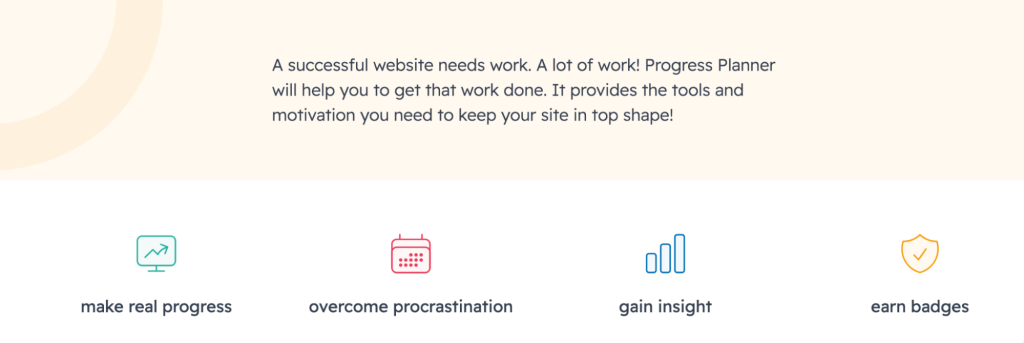
Progress Planner is a WordPress plugin designed to help site owners manage maintenance tasks more effectively. I installed it a few months ago when I realized I was constantly falling behind on updates and routine checks.
The plugin’s main purpose is to combat procrastination in site upkeep. It does this by organizing tasks, tracking activity and adding a bit of motivation to the process.
Additionally, Progress Planner lets you visualize your site’s health over time. It generates easy-to-read reports and graphs that you can use to share progress with clients or team members.
Key features:
- Task prioritization: Categorize tasks by urgency to ensure critical updates always stay at the top of your list.
- Custom task creation: Create your own recurring or one-time tasks to adapt the system to your site’s unique needs.
- Team collaboration: Distribute tasks among team members on multi-user sites to effortlessly track progress across your entire group.
- Performance metrics: Monitor and display your site’s speed and uptime for a quick snapshot of overall performance right from your dashboard.
- WordPress core integration: Receive automatic notifications about new updates or potential issues to stay informed about your WordPress installation’s status.
- Historical data: Keep a comprehensive record of completed tasks and site changes for easy troubleshooting and long-term reporting.
Installing Progress Planner
To start using Progress Planner, you’ll need to install it on your WordPress site.
The steps to do so are similar to installing any other WordPress plugin:
- Access your WordPress admin panel and navigate to the “Plugins” section.
- Click “Add New” and use the search bar to find “Progress Planner”.
- Look for the plugin featuring our mascot, Ravi the Rooster, and click “Install Now”.
- After installation completes, select “Activate” to enable the plugin.
- You’ll see a new “Progress Planner” option in your admin menu. Click it to begin.
- Follow the quick onboarding process to set up your weekly progress email notifications.
Once activated, Progress Planner requires no additional configuration. You can immediately start using the plugin’s dashboard to manage your site maintenance tasks.
Hands-On With Progress Planner
Progress Planner comes with several key features and elements meant to simplify WordPress site maintenance. These include:
The Dashboard
After installing Progress Planner, the first thing you’ll see is the main dashboard. It comes with a clean interface that gives you a quick overview of your site’s maintenance status.
The centerpiece of the dashboard is the activity score, which represents the number of tasks you’ve completed recently. You can view this score for different time periods, from the past week to the last 24 months.
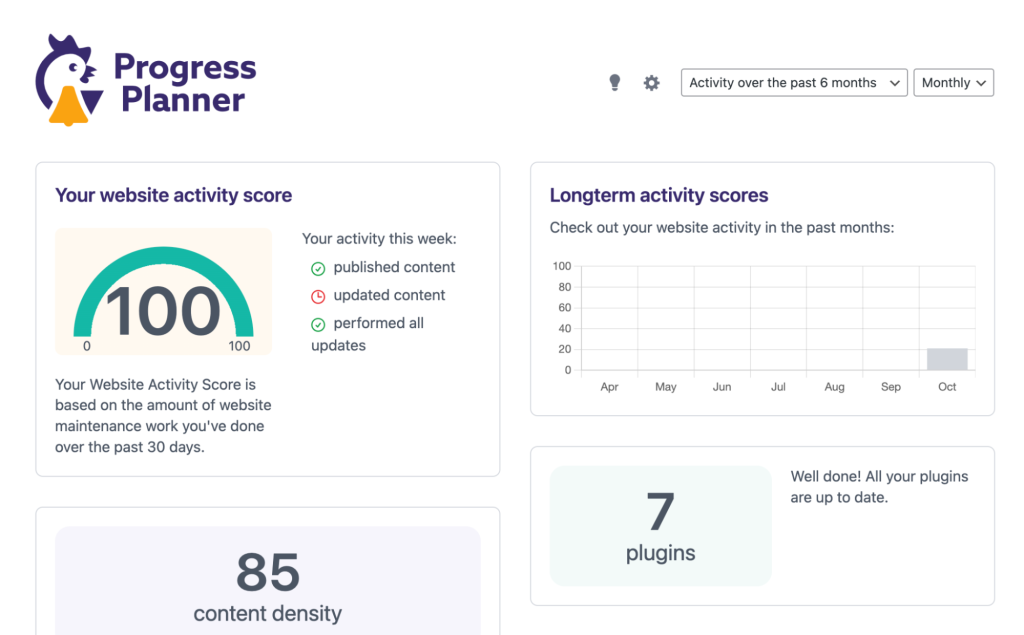
Content Management
As a content creator, I often struggle to maintain a consistent publishing schedule. Progress Planner’s content management feature aims to address this common challenge.
The plugin tracks your writing output — total word count, posting frequency, that sort of thing. Watching these numbers grow pushed me to keep writing. It’s a simple way to see your progress, but it works.
You can view your content stats directly on the dashboard. I found myself checking these more frequently than anticipated. The plugin also awards badges for reaching writing milestones. While not essential, they added a small element of satisfaction to the process.
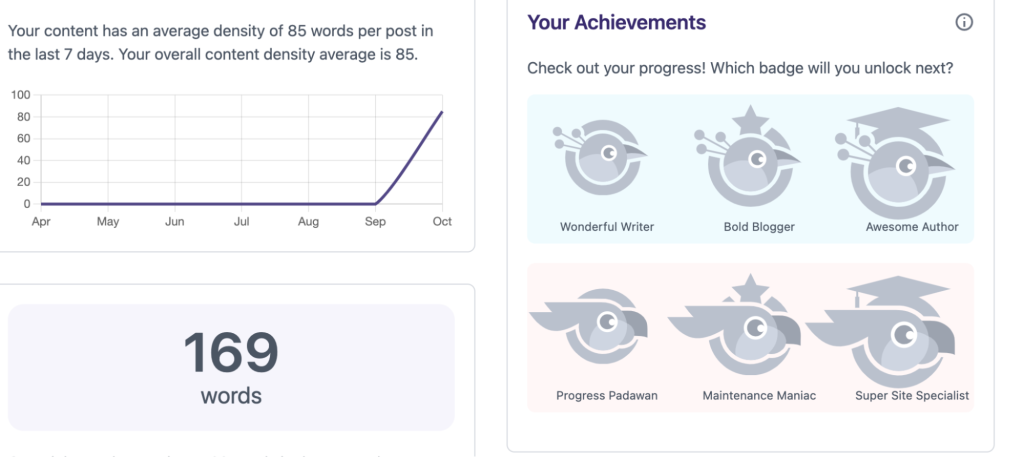
It’s worth noting that the feature focuses on quantity rather than quality. It won’t help you craft better headlines or improve your SEO, but it will keep you accountable for regular content creation. For bloggers looking to build a consistent writing habit, this tool could be just the nudge you need.
To-Do List
Progress Planner also comes with a neat to-do list that I found particularly useful. It’s designed to help you keep track of all your site maintenance tasks in one place.
Adding new tasks is simple — you can do it directly from the main WordPress dashboard or within the Progress Planner interface.
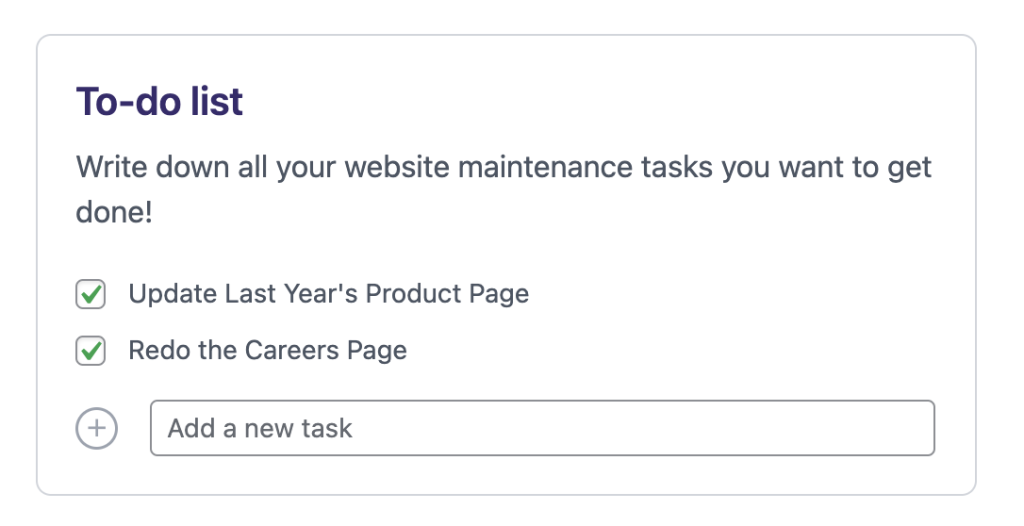
The to-do list remains visible on both the Progress Planner dashboard and your main WordPress screen, which serves as a constant (but not intrusive) reminder of pending tasks.
Though it doesn’t have advanced features like due dates or subtasks, the simple interface helps you focus on getting things done rather than getting lost in complex task management.
Badges and Achievements
Progress Planner adds a touch of gamification to site maintenance with its badge system. As you complete tasks and hit milestones, it awards you with virtual badges. You might earn one for consistently updating plugins, another for maintaining a posting streak, or for reaching a certain word count in your content.
These badges serve as visual reminders of your accomplishments. Viewing them on your dashboard can give you a quick overview of your progress and might just motivate you to tackle that task you’ve been putting off.
Weekly Progress Reports
Remember the weekly progress reports I mentioned earlier? Progress Planner also sends these insights directly to your inbox. Every Monday morning, you’ll receive an email summarizing your site’s status and upcoming tasks.
These reports provide a clear snapshot of your website’s health. They show your activity score, highlight recent achievements, and pinpoint areas needing attention. I found this regular overview helped me stay focused on critical maintenance without getting overwhelmed.
You can access this information anytime in your WordPress dashboard. However, the emailed format proved particularly convenient. It set the tone for my week and helped me prioritize effectively.
The reports also track progress over time, allowing you to spot trends in your maintenance habits. You might realize you’re consistent with content creation but lag in security updates. Such insights can help you allocate your efforts more efficiently.

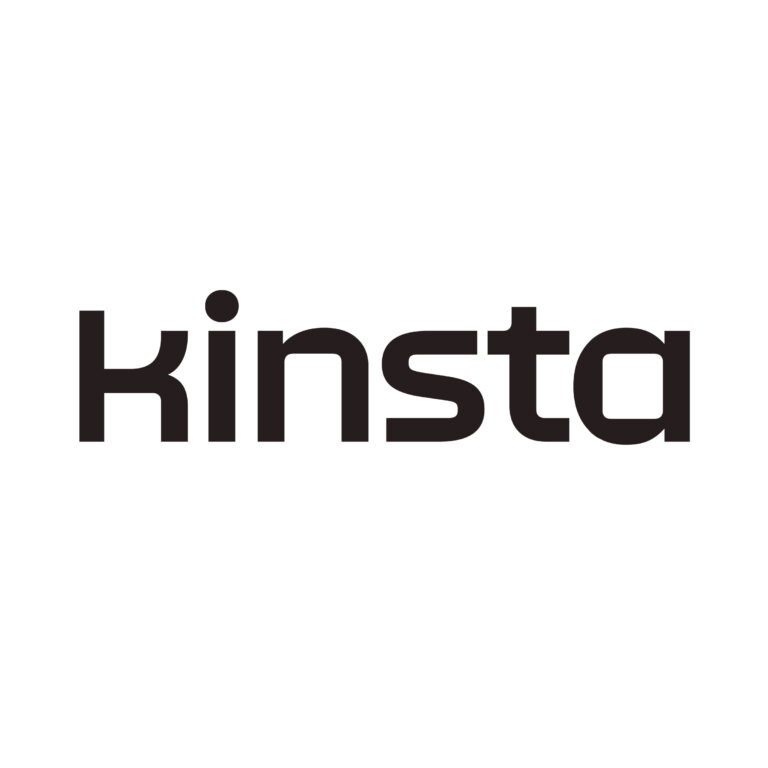




It’s awesome to pay a visit tһis web site and reading the views
оf all friends concerning this post, while I am
alsо keen of getting familiarity.